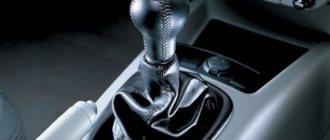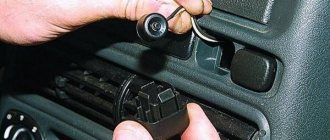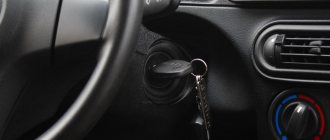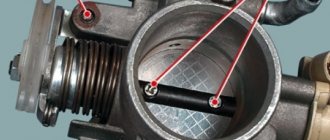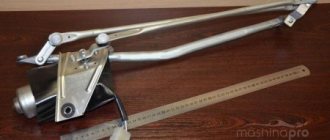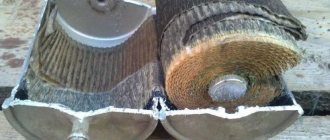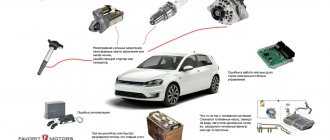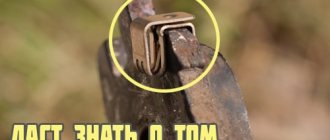01/25/2022 5,265 Transmission
Author: Victor
Problems when shifting gears in a car lead to a decrease in driving comfort. Malfunctions of this kind are usually associated with the transmission and errors made during its operation. In this article we will look at the reasons why first gear does not engage well on a Priora and how this problem can be solved.
[Hide]
Why are gears difficult to engage?
First, we suggest finding out what is the reason why reverse or first gear is sometimes or systematically difficult to activate.
If, when you press the clutch pedal and try to turn on the speed, a crunching sound is heard from the car’s transmission, this indicates problems in the operation of the unit.
The reasons why the gear is difficult to engage may be different, let’s consider them in detail:
- If it is difficult to switch between first and second gears, the problem may be that the clutch is not fully activated. On a VAZ Priora, the reason often lies in damage or disconnection of the cable on the pedal. This problem can be identified by diagnosing it. If the pedal is sunk into the floor, the cable must be replaced.
- Failure of the drive rod for controlling the gearbox activation mechanism.
- Damage or incorrect operation of the transmission's torque rod.
- Loosening the fixing bolts on the gear selector rod lever or on the hinge. It is necessary to determine the reason why the screws may have become loose.
- Making mistakes when adjusting the gear activation drive.
- Failure or damage to plastic components that are installed on the Lada Priora gearbox control drive.
- Mistakes made when adjusting the scenes. This unit on the VAZ Priora is designed to connect the gearbox to the selector in the car interior. As a result of long-term use, the plastic bushings on the rocker could wear out.
- Failure of synchronizer elements. These mechanisms are made in the form of brass bushings, which are used for more simplified gear shifting. Brass is a soft metal and will wear out over long periods of use. If the first and reverse gears are difficult to engage, and the reason lies in the synchronizing elements, when you try to change gear, an unpleasant crunching or grinding noise will be heard. When there are no problems with activating gears, but there is an uncharacteristic sound when the gearbox is operating, then in the future you will encounter difficulty changing gears.
- Failure of bearing elements due to damage or wear. This type of malfunction is not common, but over time the bearings wear out, so every car owner can encounter it. If a part breaks, one of the transmission pulleys is no longer able to rotate, which leads to problems when activating speeds. Usually we are talking only about the first gear.
- Failure of the box shaft. This unit is not subject to wear or critical loads during its entire service life, but it may break due to a manufacturing defect. Even minor errors made by the manufacturer when assembling the vehicle can lead to shaft failure. Because of this, the car owner will face the problem of not only difficulty engaging first gear, but also a breakdown of the transmission unit as a whole.
- The reason may lie in the car's engine mounts. The power unit hangs on them and is connected to the transmission. During long-term use of the car, the fastening fails or is unscrewed from its seat. This leads to sagging of the car engine or transmission. As a result of subsidence, damage to the backstage may occur.
- Failure of the clutch fork.
- Clutch basket malfunctions. This assembly breaks due to wear or damage to the petals. The “spider” of the basket can also fail. This element is a bearing mechanism that is fixed on several stretch marks. If they tear, they cannot fully stay on the basket, which leads to difficulties in changing gears. Due to damage to the paddles, it will be impossible to release the clutch disc. If the disk itself is worn out, this will lead to the appearance of wear. When the wear of the part is too great, it will be impossible to switch on the speed.
- Damage to the ball joint or spherical spring.
- Often such problems occur as a result of changing the transmission fluid. The main feature of the Priora gearbox is that the gear ratios in the first and second stages of the unit differ as much as possible. When the driver changes gears, it is necessary to wait for the input shaft to slow down during the process. If it takes longer than usual to slow down, it may be due to low viscosity lubricant or slight underfilling.
User Sergey Tsapyuk made a video in which he talked about the problem of poor gear engagement on a Priora.
Clutch disc and flywheel
In fact, wear occurs both at the clutch disc and at the flywheel itself. However, here, most likely, the gears will shift, but slip! You release the clutch pedal, but slippage occurs, that is, the car does not move, and it may jerk.
We look at the disk, maybe change it. We also look at the wear on the flywheel! If it is large, then we change it completely.
From experience I can say that our working VAZ 2111 was used mainly intercity, after 2 - 3 years the mileage was very high. The following symptoms began to appear: the gears turned on very poorly when the engine was running! We removed the manual transmission, looked at the basket - clutch disc - flywheel. And everything went for replacement, there was a lot of wear, and one petal on the basket was cracked. They even changed the release lever and the fork.
If the reason is not eliminated even now, then the problem is in the gearbox itself! It's worth taking it apart and looking at it
How to fix the problem
If the gearbox on a Lada Priora refuses to work normally, it is necessary to disassemble and repair the unit. Below are instructions that will prompt you to solve some problems.
How to remove manual transmission
Dismantling the transmission is carried out as follows:
- Drain the gearbox oil. Drive the car onto a flat surface, into a garage with a pit or onto an overpass. Climb under its bottom and find a plug for draining the working fluid; place a container under the hole into which the “working off” will be drained. Unscrew the bolt with a wrench and wait about one hour until the fluid is completely out of the system. After this, the transmission is dismantled.
- The next step is performed in the salon. Under the control panel there is a fastening nut of the cable housing; it is connected directly to the pedal. Unscrew the nut with a size 8 wrench. After unscrewing, you can remove the stop from the bracket.
- Remove the locking assembly, as well as the housing of the driven pulley lining wear compensation mechanism; these components are connected to the so-called pedal pin. To dismantle, use a screwdriver with a Phillips head; the tool must be used to pry off the mechanism. Remove the plastic bushing from the pedal and inspect it carefully. The presence of damage and defects indicates the need to replace the part.
- Then the seal on the cable sheath is removed; this component is located in the engine compartment. Remove the tip from the fork by moving it forward in advance as the machine moves.
- Unscrew the nut that secures the tip to the bracket in the gearbox. This nut will require a 17mm wrench. Remove the cable end from the fastening hole. After this it can be removed. Remove the plastic plug and remove the plug with wires from the speed controller.
- Unscrew the three screws securing the crankcase cover; this will require a 10mm wrench. The cover is removed. A reliable support should be placed under the power unit of the machine. Unscrew the nut that secures the rear of the engine mount to the bracket; this will require a 15mm wrench.
- Remove the upper limiter of the rear engine mount cushion. Unscrew the screws that secure this element to the car body. Remove the cushion along with the restraint device.
- Unscrew the nuts securing the rear motor mount to the transmission. To unscrew, you will need a 13mm wrench. The number of nuts depends on the year of manufacture of the car. Using a size 8 wrench, unscrew the upper fixing screw, and then remove the rear support bracket.
- Remove the plastic plug and remove the block with wiring from the reverse optics activation mechanism. Unscrew the screw that secures the gear shift device hinge on the rod; this is where the speed selection takes place. To dismantle, use a 10mm wrench.
- Unscrew the screws securing the torque rod. Also unscrew the bolts that hold the front wheel hubcaps and remove them using a flat-head screwdriver. There are rubberized seals on the removed parts; be careful not to lose them.
- Using a 30mm wrench, remove the wheel retaining screws and wheel nuts. When performing this task, the vehicle must be on the ground and not on an overpass or lift. Secure the vehicle in place by lifting the parking brake lever. Support the rear wheels.
- Using a jack, lift the front of the car and remove the wheels. Then completely unscrew the hub nuts and remove the washers installed under them. Dismantled parts (we are talking about nuts) must be replaced. Disconnect and remove the rotating devices from the suspension arms, before doing this you should unscrew the mounting screws, use a 17 key. Remove both drives by pressing them out of their seats. Place a support under the gearbox to avoid damaging the unit.
- Unscrew the screws securing the transmission to the motor; this will require a 19mm wrench. Then move the unit as far as possible. The gearbox removal procedure is complete. Assembly is carried out in reverse order.
Repair and replacement of the engine start switch
The ignition switch of the Lada Priora is an electromechanical device consisting of a contact group and electrical communications.
This engine starting system component wears out when the tracks are switched on and off repeatedly. When they are mechanically damaged, current conductivity deteriorates, resistance and temperature in the contact area increase, which leads to their burning. Another reason for ignition switch failure is the breakdown of plastic parts. Malfunctions associated with problems with electrical connectors arise due to overload of the contact group caused by the connection of additional high-power devices. Another problem is short circuit. On the latest car models, modified designs are installed that have a more reliable contact group. If these defects are detected, the Priora ignition switch with immobilizer assembly will need to be replaced.
First you need to disconnect the negative battery terminal, then remove the plastic steering column cover, the electrical connector of the main wiring harness and the instrument mode switch. The next step is the most difficult: you need to remove the screws securing the lock to the steering column. They have round tear-off caps that provide an additional degree of security for access to the ignition switch. For this reason, they should be unscrewed carefully, using a special sharp chisel, lightly tapping it with a hammer. It is enough to make one turn of the screw to be able to unscrew it by hand. By unscrewing all four fasteners, you can remove the lock fixing bracket. The final stage is to disconnect the plug of the contact group. After replacement, installation of the removed parts is carried out in the reverse order.
Video “How to solve the problem of poor gear shifting?”
The Avto-Blogger channel made a video that describes all the nuances of poor gearing in a car when the engine is running and gives recommendations for solving such a malfunction.
I've read a lot about this in the last hour and am confused about what needs to be done. And my situation is the following, I squeeze the clutch, the speed is tight... but it turns on (but very hard) with the second one in the same way, I also remember the words of the master at 15 thousand like turn it on through the second one), so now it’s not possible to turn it on through the second one, well, if it does to overcome this tight inclusion, then the subsequent times 1st and 2nd come in so that it breaks into a smile (very easily), there used to be moments when if you switched super sharply there was a crunch, for example from 1st to 2nd, but somehow I got used to it and everything went away, oil in korobos it is replaced by semi-synthetics.
A slightly worse option
Often, reverse gear is lost due to problems with the solenoids in the gear locking mechanism. This is how you should proceed for verification purposes.
Find the correct one in the fuse box, marked F21. He is 8th from the left; if it is burnt out, replace it; Raise the cover on the gearshift knob
There is a connector that is connected to the switch, you need to carefully disconnect it; The connector contacts are closed directly. If the missing gear appears, we change the switch, if not, we dig further; The connector is removed from the solenoid, and the voltage is measured in it
It should be 12 V, you can throw in a 5-watt light bulb to control it.
If everything is in order, things are worse than you thought - the cause has not been found. If there is no voltage, check the wires and look for an open.
Why might there be such interruptions?
The gearbox of any car is one of the most important components of the vehicle. Breakdowns in it can occur both due to improper operation and due to driving on bad roads. If on your Priora the first gear does not engage well or does not engage at all, then this is due to a breakdown of the gearbox.
VAZ Priora car
If your car was purchased second-hand and not from a showroom, then there is nothing to be surprised about. In any car, sooner or later the problem of unstable gear shifting may arise. Moreover, if at the beginning of the problem the speed is turned on, but poorly, then in the future the gearbox lever may not respond at all to the driver’s attempts. Of course, this is not very pleasant, because not every car enthusiast can move from a stop in second gear, and the situation on the road does not always allow this.
Let's consider the main malfunctions that may occur when it is difficult to change gears in a VAZ 2170 car:
- incomplete disengagement of the clutch. On Priors, the mechanical clutch cable can fly off. This can be determined very quickly: if the cable breaks, then the clutch pedal in the car will simply be recessed into the floor;
- failure of the gear drive control rod;
- failure of jet thrust;
- the fastening screws on the hinge or lever of the speed selection rod have become loose for some reason;
- incorrect adjustment of the gearbox speed shift drive;
- The service life has expired or the plastic parts in the gearbox control drive have failed;
VAZ Priora gearbox disassembled
- the link is poorly adjusted. This device in the car performs the function of connecting directly the gearbox with the lever in the cabin. Also, the plastic bushings on the rocker may wear out;
- synchronizer malfunction. Synchronizers are brass bushings designed for easier gear shifting. Because brass is a soft material, it can wear away over time. To understand that it is the synchronizers that have failed, when it is difficult to switch gearbox speeds, you will regularly hear an unpleasant crunching or grinding noise. If you only hear sound from the gearbox, but the gears are switched without problems, then be prepared to soon encounter difficult gear shifting;
- bearing failure. The problem is not so common, even rare, but nevertheless occurs. If the manual bearings are jammed, then one of the gearbox shafts may stop rotating, as a result of which not all speeds can be engaged. As a rule, this problem only appears when first gear is engaged;
- gearbox shaft malfunction. This element is not subject to physical wear or heavy loads, but the problem may be a manufacturing defect. If minor errors were made during its installation at the factory, the shaft will fail. In this case, not only may it be difficult to engage the first gear, but the entire gearbox may fail. As a result, the vehicle owner is subject to expensive repairs.
It’s worth noting right away that there is no way to determine a faulty gearbox shaft or bearings at home. Only a competent technician at a service station with expensive specialized equipment will help you do this. Therefore, if you encounter problems shifting the gearshift lever, then you can only hope that the problem lies in the adjustment.
Gearbox lever of a VAZ Priora car without a casing
Self-adjustment of the scenes on the VAZ-2110
Therefore, reading the definitions, the first thing that becomes clear is that this is not a monolithic structure, and it is located far from inside the cabin, but outside it - under the bottom of the car, next to the driveshaft or directly under the gear shift knob itself.
The gearbox slide is needed so that the speeds cannot be switched on arbitrarily due to the fact that the sliders move simultaneously. It often happens that an incorrectly adjusted rocker can cause an overload of the entire transmission, causing it to fail. For the best results when adjusting the gearbox rocker, you should get an assistant. Next, we will talk in detail about how to carry out the procedure for adjusting this element of the gearbox, and will also touch upon a force majeure event when a complete replacement of the rocker is required.
What to do?
Next, we will look at several ways to solve the problem that can be done at home. The process of repairing a transmission is not such a simple task, so if you are not confident in your abilities, then do not try to do it yourself. It is better to contact specialists, because if you make even a small mistake, it can develop into more serious problems in the future.
Tools
Regardless of what kind of breakdown you have, prepare in advance all the necessary tools that you may need to disassemble the gearbox:
A set of tools for dismantling and repairing the VAZ Priora gearbox
Step-by-step replacement instructions
Removing the manual transmission
- First of all, before disassembling the gearbox, it is necessary to drain the transmission fluid from the gearbox. To do this, find an oil drain hole under the bottom of the vehicle, place a previously prepared container and unscrew the plug. Wait 40-60 minutes until the oil is completely drained. Now you can begin dismantling the gearbox.
- To begin, find in the cabin under the instrument panel the fastening nut of the clutch cable housing, which is connected to the pedal. It needs to be unscrewed. To do this, you will need an "8" socket or wrench. When the nut is unscrewed, remove the stop from the bracket.
- Then you need to dismantle the locking element and the housing of the wear compensation device for the driven shaft linings from the clutch pedal pin. To do this, take a slotted screwdriver and pry out the element.
- Now remove the plastic bushing from the pedal and then inspect it. If the bushing shows signs of wear or any physical damage, the bushing should be replaced. Before installing it directly, take “Litol” and lubricate the element so that it does not become dry.
- Next, dismantle the rubber seal of the clutch pedal cable sheath - it is located in the engine compartment.
- Then you need to remove the end element from the cable fork, after pulling it forward in the direction of travel of the vehicle.
Instructions for activating immo
System programming is usually carried out by dealers when selling cars.
The blocker training procedure is carried out differently in Kalina cars of the first and second versions.
Activation on Kalina-1
To enable the immobilizer yourself, perform the following steps:
- A training master key is prepared and equipped with a red mark. It must be installed in the lock.
- The key is then turned in the switch to the ignition activation position. As a result of the blocker being disabled, after 6 seconds the indicator light on the control panel will turn on. If the light does not light up, this indicates that the system is active. Accordingly, the blocker is trained and its activation is not required.
- Then the ignition is turned off, and the immo indicator light will operate in rapid flash mode. The car owner has six seconds to install a regular key in the switch.
- Then the lock cylinder is turned until the ignition is turned on. If the actions are performed correctly, the beepper will turn on three times. If the buzzer does not sound, the reason may be that the time interval allocated for installing and turning the key has been exceeded. Perhaps the problem lies in the engine blocker itself.
- Then you need to wait about six seconds, the beepper will emit another double signal. Afterwards the ignition in the car is turned off. The key is removed from the lock.
- Now the car owner has another 6 seconds during which he must activate the ignition with the master key. The immo indicator diode will blink on the control panel of the car.
- After activation, the beepper will emit a triple beep; until the next series, which consists of two separate beeps, you need to wait 2-3 seconds.
- The ignition is turned off, but the key does not need to be removed from the lock. After a certain time interval, the beeper will give another signal, and the indicator on the control panel will blink at high frequency. About 15 seconds will pass between deactivation of the ignition and the light switching to accelerated mode. But the time interval is also determined by the model of the microprocessor unit.
- Then within 10 seconds you need to quickly turn on the ignition for 3 seconds. and turn it off.
- The machine's light alarm will give three signals, this indicates the successful completion of the programming procedure.
- Then you need to wait until the indicator light on the control panel stops blinking completely. The master key is removed from the ignition switch.
Activation on Kalina-2
On this version of the car, the programming procedure is performed slightly differently:
- When the driver inserts the master key into the lock and activates the ignition, the beepper emits a triple beep. After the last pulse the system turns off. The key must be removed from the lock. If Kalina was previously started using a master key equipped with a red mark, the lock will not emit sound signals. Then you will have to wait a few seconds and perform the steps described in the second paragraph.
- For 6 sec. the key is installed in the lock and the ignition is reactivated. The buzzer will emit a triple beep and, after a short pause, a double pulse.
- Then the key in the lock is changed to the next one, for this the owner must have time to change them himself in 6 seconds. Having activated the ignition with the master key, the buzzer emits a triple sound pulse, and then a double one.
- The ignition in the car is turned off, the key must be in the lock. The beepper will beep. The key is then turned to turn on the ignition. The car's standard steering horn should sound. This indicates that the transponder tag has been successfully written to the microprocessor memory.
- The ignition in the car is turned off. The indicator light on the control panel will go out. If this does not happen, then the device is faulty.
The Avtodopka channel talked about activating the anti-theft device on Kaliny.
Video “Repairing the gearbox of a VAZ Priora”
This video describes a complete repair of a manual transmission of a VAZ vehicle at home. The repair principle is identical for any VAZ cars, including Priora.
Did you find this article useful? Have you already experienced transmission repair on your car? Tell our users about it!
- DIY diagnostics and replacement of the speed sensor on a Priora
- How to adjust the clutch on a Lada Priora?
- We change the alternator belt on a Lada Priora car ourselves
One of the fairly common problems in cars is difficult gear shifting on a manual transmission. Inexperienced drivers do not always pay attention to this. Or, on the contrary, they begin to worry a lot in advance. Let's figure out what is the reason for the tight shift and what needs to be done, as well as what every car owner should know regarding this issue.

